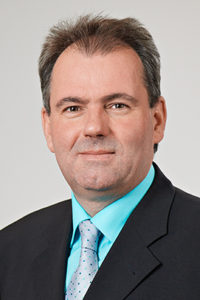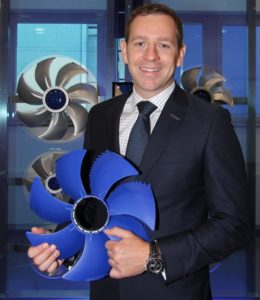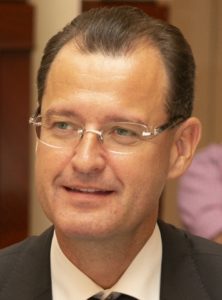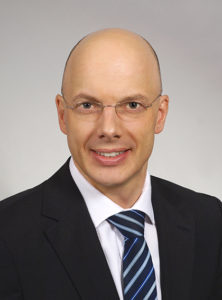While opinions regarding Germany’s ability to meet its ambitious environmental targets vary among stakeholders, these very targets have undoubtedly enhanced efforts to improve building performance. How are HVAC manufacturers navigating the regulations that have emerged as a result, while maintaining competitive advantage and keeping up with consumer demand? Hannah Jo Uy has the story…

Thomas Damm,
Technical Manager, Sector Department, Air Conditioning and Ventilation Technology, VDMA
The most environmentally friendly and cheapest energy is that which is not consumed in the first place,” says Thomas Damm, Technical Manager, Sector Department, Air Conditioning and Ventilation Technology, VDMA. This, he says, is why energy efficiency is viewed as key to unlocking the country’s objectives, namely Climate Action Programme’s 2020 interim target of a 40% reduction in greenhouse gas emissions compared to 1990 levels, as well as those under the German National Action Plan on Energy Efficiency (NAPE).
With the building sector accounting for 40% of final energy consumption in Germany, and around one-third of greenhouse gas emissions, Damm says, the sector plays a key role in the country’s comprehensive energy and climate policies. “To this end, the German government has set itself the ambitious goal of achieving an almost climate-neutral building stock by 2050,” he says. “This means that primary energy requirements will be reduced by 80%, compared with 2008.” To achieve this, Damm says, the energy requirement for heating and cooling, as well as for ventilation technology, must be significantly reduced through efficiency measures and the share of renewable energies, in meeting the remaining demand, significantly increased.
With European and national laws impacting air conditioning and ventilation technology, Damm says the challenge for politics and the industry is to decouple CO2 emissions from economic growth. “In Germany, in addition to the Renewable Energy Sources Act (EEG), the German Energy Saving Ordinance (EnEV) is primarily relevant,” he says. “The latter implements Energy Performance of Buildings Directive (EPBD) nationally and defines energy requirements for buildings and the technical building systems and installations contained therein. In addition to air conditioning and ventilation technology, this includes heating technology.”

Jens Schuberth, Umweltbundesamt
Citing the September 2018 prohibition of the marketing of high-voltage halogen lamps in the European Union (EU) as an example of the continuous impact political programmes have on technologies’ market viability, Damm highlights the political will in the EU to steer markets toward its environmental agenda. Jens Schuberth, Umweltbundesamt (UBA; The Germany Environment Agency), believes German HVAC manufacturers are
on track when it comes to complying with regulations, due to the time afforded to them prior to the implementation, based on observing new product lines, with features reflecting the new requirements.
Forces driving manufacturers’ compliance
While Schuberth says market compliance is also reflective of Germany’s recognition of EU directives as a member state, Damm adds that voluntary adoption can also be attributed to system operators’ move to cut operating costs. “The continuous increase in the number of central ventilation and air-conditioning units equipped with heat-recovery measures, shows that this can also be done without bans,” Damm says. “Numerous factors can be decisive here — rising energy costs, certification systems for buildings user requirements or financial support measures by the public sector and/or state financial institutions.” Ultimately, Damm says, it is a mixture of instruments, constraints and incentives from stakeholders.

David Miller, Managing Director, Ziehl-Abegg Middle East
David Miller, Managing Director, Ziehl-Abegg Middle East, provides a manufacturer’s perspective, saying that while, admittedly, the move towards energy-efficient solutions is influenced by political pressure, many customers are also seeing the advantages of investing in such technologies with an eye towards operational savings. “When it comes to design, people are changing their ways,” he says, “which is positive in our point of view.”

Markus-Erich Strohmeier, Senior Executive Vice President, Siemens Building Technologies – Middle East
Markus-Erich Strohmeier, Senior Executive Vice President, Siemens Building Technologies – Middle East, echoes the need to comply with customer requirements. “When considering cost, we believe it’s important to take into account the lifecycle of the technology and the impact it will have on the efficiency, availability, reliability and operating costs of a customer’s infrastructure during that time,” he says. “Ultimately, we want to ensure that our customers have all the data they need to make an informed choice regarding a product or supplier.”

Bissan Abbas, Managing Director, Techem Energy Services Middle East FZCO
Bissan Abbas, Managing Director, Techem Energy Services Middle East FZCO, adds that the growing attractiveness of energy-efficient solutions over conventional systems is also driven by rising costs in bigger cities over the years and that compliance with regulations has encouraged stakeholders to thoroughly study ROI to reach a break-even point.
The need for more stringent market surveillance and enhanced efforts towards IAQ
Overall, Damm says that manufacturers view regulations as positive tools for market transformation, towards more efficient products and systems. “It has also been shown in the past that German companies, in particular, with their highly developed products, manufactured with very good quality, have a market advantage — albeit limited in time — over competitors from outside the EU.” This advantage, he stresses, would be even higher if the market surveillance stipulated by the European legislator and given to the EU member states for implementation is carried out. “However, the system is unfortunately weak and also makes market access possible for products that do not comply with EU law,” Damm says.
Schuberth echoes this, adding that despite energy efficiency inspections on air conditioners having been introduced in Germany as early as 2007, as part of the EU [Energy Performance of Buildings] Directive requirement, this has not been carried out to the extent necessary or expected. The inspections, Schuberth stresses, aimed to identify areas of improvement for building owners, in order to present them with the most economically attractive solution. “Three years ago, Germany started to register all inspections,” he says. “Only one-tenth of the inspections that people expected were carried out. So, there is quite a lack of surveillance and this is a great potential to improve air conditioning and ventilation.”
Another potential area of improvement that Damm believes requires greater attention is IAQ, which, he says, merits the same enthusiasm afforded to energy efficiency. “It is well known and proven that good IAQ is profitable in many ways,” he says, pointing to the indoor comfort in offices, shopping centres and schools, “but currently there are no legal requirements yet related to IAQ in residential and non-residential sectors.
What is there are recommendations from the WHO and the Federal Environment Agency in Germany. However, these are merely recommendations, compliance with which is not mandatory.” Damm says that this is incomprehensible, given that people spend most of their time inside buildings, arguing that much has already been said about the importance of energy efficiency.
Damm stresses that it is important that IAQ and energy efficiency are not considered separately or played off against each other. “The filter industry shows and proves it,” he says. “High-quality air filters enable a higher IAQ, with comparable or lower lifecycle costs over the service life of the filters. And this also applies to higher acquisition costs compared to lower-quality air filters. Improving the efficiency of air filters can help to ensure that IAQ does not remain a stepchild.”
Germany is not sitting on its laurels, as new regulations are underway that could potentially address these gaps. Damm says manufacturers and users are eagerly awaiting the new revision and redesign of legislation for buildings and technical installations, which has been announced by politicians for some time. “Specifically, the existing national legal provisions of the Energy Saving Act (EnEG), the Energy Saving Ordinance (EnEV) and the Renewable Energies Heat Act (EEWärmeG) are to be combined into a new regulation,” he says. “This awaited regulation is called the German Energy Act for Buildings (GEG).”
Schuberth says the lack of market surveillance and inspections could be addressed by the new regulations, recommending more effective controls over the energy performance certificates of the buildings. “There is the idea to have information in the building certificate of existing air conditioners that had to be inspected,” he says. “If the energy performance certificate were to be controlled, they could ask for inspection of air conditioners. It’s quite an indirect way that we hope could have some effect.”
Schuberth says that, additionally, gaps in market surveillance could be addressed by making air conditioners smarter, through the integration of monitoring equipment that detect operational efficiency and report to building owners in the event there are deficiencies. While promising, Schuberth says, this would be mainly applicable to new air conditioners.
Industry 4.0: The inevitability of the Internet of Things
With this recommendation, Schuberth touches on another observable trend in Germany: digitalisation. Citing “Industry 4.0” as the buzzword for 2018 in Germany and Europe, Damm says the advancing digitalisation in production and enhanced communication of devices offers new possibilities towards greater efficiency.
Miller shares a similar observation, reporting that customers are demanding more from their products. “The buzz word is cyber-physical systems,” he says. “Everything speaking to each other and manufacturers offering a lot more feedback that we did in the past.” Miller says this has prompted Ziehl-Abegg to work towards having the capability to connect networks to physical devices, such as sensor fans, frequency inverters and motors, to monitor health and efficiency. “This is an exciting time for us in terms of innovation dictated by our customers and this shift towards energy savings,” he says.
Strohmeier highlights how digitalisation is changing “the way we plan, design, build and operate infrastructure”. He says, “We see technologies, such as augmented reality and virtual reality increasing efficiency over the whole lifecycle of a building. Remote access, maintenance and servicing is gaining increasing relevance, and indoor positioning technology also has the potential to revolutionise the way we manage our infrastructure.”
Strohmeier stresses that Building Information Modeling (BIM) is a key topic that will have significant impact on the HVACR market.

Rolf Werner, Director Application Engineering, Wieland
Damm describes BIM as a developing tool for the optimised execution of construction projects. “BIM can and should consider all phases,” he says, “In the best case, BIM accompanies a building or plant from the first stroke of a pen to its demolition.” Damm stresses that through BIM, planning can be done in a cost-effective way to avoid typical building hazards and problems, such as, for example collisions of ducts and tubes, which can be identified early on in the design phase, and addressed by developing and implementing the most suitable solution. He adds that BIM also helps data management to optimise operation and maintenance. “Functioning BIM projects, which are kept up-to-date over the entire period of time, can prevent losses of important information, such as design calculations, design and construction plans or product documentation,” he says. “BIM is a growing system into which all participants must contribute. Anyone who deals with BIM and its possibilities will recognise the opportunities and risks.”
Rolf Werner, Director Application Engineering, Wieland, weighs in, saying that he believes that Germany is, in fact, lagging behind other countries in terms of automation, especially when it comes to BIM. However, Werner commends the platform’s ability to supply necessary data for an integrated process.
Enablers of energy efficiency
While the country still has some way to go, Damm says German companies’ commitment to sustainability has helped paved the way for manufacturers to be technological leaders, globally. “The applicable regulations and their enforcement in the market have a major influence on the use of sustainable technology outside the EU,” he says. “It is clear to see that numerous states in the Middle East are using ordinances and technical regulations as basis for buildings and technical building systems to become increasingly more efficient.”
To underscore his point, Damm says that in the first half of 2018, North Africa and the Middle East accounted for approximately three per cent of air-handling technologies’ total exports. Damm adds that sales of the German air conditioning, ventilation and refrigeration technology industry are expected to grow by a total of five per cent in 2018. Calling German manufacturers, “enablers” in the sector, Damm says, it is only a matter of time before the efficiency wave also reaches farther regions of the world.
Hannah Jo Uy is Assistant Editor at Climate Control Middle East magazine. She may be contacted at hannah@cpi-industry.com
Copyright © 2006-2025 - CPI Industry. All rights reserved.